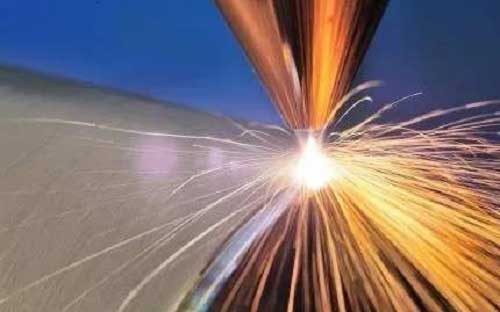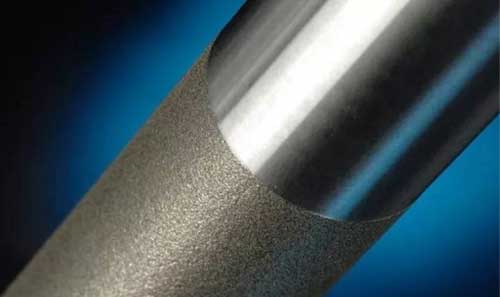High speed laser cladding will replace hard chrome and plating.(HY-marketing department)
As of September this year, EU countries may not allow the use of hard chrome plating in metal parts. Based on this situation, another process is needed instead of hard chrome plating. Thermal spray has been tested for high flexibility, but the results of the tests are often poor. Another very good alternative to hard chrome plating is the ultra-high-speed laser cladding recently developed by scientists at the Fraunhofer ILT in Aachen, Germany, using equipment from Laserline, Germany.
In power plants or other industrial manufacturing plants, the metal parts of mechanical equipment are often subjected to great tests in terms of wear and tear. Process parameters and general production environments are often poor, leading to corrosion and wear of some of the most important metal parts. In order to cope with these situations and to extend the service life of some particularly expensive production equipment, the metal parts of these equipments are coated with a special coating. The entire surface of rotating parts, tubes and other functional parts is provided with a metal or ceramic coating.
This increases the corrosion resistance of the workpiece to heat, moisture, aggressive chemicals, and metal debris and spatter. The processing that is often used is an early method called hard chrome plating. It is an electroplating method in which a workpiece is immersed in a chromium electrolyte and thus covered with a chromium layer. If a special part does not require a coating, the part will be wrapped before being immersed in the electrolyte solution. It is especially suitable for large-format and large-sized parts, and the selection area next to it is also possible to coat.
Chrome plating or will be banned, new coating technology is imperative
The future development of hard chrome plating has not been finalized. Although hard chrome plating is very successful at this stage, the commonly used chromium oxide (CrO3), also known as hexavalent chromium (Cr6+), together with other chromium-containing substances has been adopted by the European Commission. Defined as hazardous to humans in 2013 and included in Article 14 of the Annex to the Regulations on the Registration, Evaluation, Authorization and Restriction of Chemicals, this is often discussed in the Regulations for inclusion in the Annex. Use of chemicals of “Substances of Very High Concern” (SVHC). Starting in September 2017, these substances can only be used after obtaining a special and limited period of certification from the European Chemicals Agency. The procedures for obtaining these certifications are complex and can encounter some thorny issues even during the application process. For example, it must be proven and guaranteed that any SVHC (Substances of Very High Concern) will be used in absolute safety and that no other substance can replace the SVHC. If this is the case, the use of technically mature hard chrome plating, especially containing hexavalent chromium, may be controversial. As a result, the hard chrome-plated industry has been highly vigilant and has been defeated in a lawsuit in the European Court of Justice regarding the use of chrome.
Based on the above facts, there is no choice but to find alternatives and to provide new technologies to any business that uses the above technologies. Anyone or company that relies on chrome plating technology is putting the entire business model at risk. The problem that everyone faces together is that the alternative technology is limited, technically available and cost-effective. Thermal spraying used in the industry, the excipients are used in the form of a powder which is melted by a burner and a ‘flame’ and sprayed through a hot gas injector onto the surface of the desired coated part. The molten material is attached to the surface by mechanical bonding. Since a variety of different materials can be used as coatings, the great flexibility of this approach is manifested, and the main disadvantage of this process is the limited maximum mechanical stress level. This is due to the mechanical bond between the substrate and the coating material, which has less “negative gravity” than the bond produced by the electroplating process.
 Therefore, the coating produced by thermal spraying will wear out more quickly. In addition, thermal spraying creates porous surfaces and material layers that can easily cause cracking and often cannot be repaired by the original method. The next result is usually a partially transmissive layer that is not comparable to a hard chrome coating. In order to achieve a porosity in the range of 1-2%, the thickness of the coating will increase, which in turn affects the process cost, so it is believed that thermal spraying will replace the plating with a maximum of partiality.
Therefore, the coating produced by thermal spraying will wear out more quickly. In addition, thermal spraying creates porous surfaces and material layers that can easily cause cracking and often cannot be repaired by the original method. The next result is usually a partially transmissive layer that is not comparable to a hard chrome coating. In order to achieve a porosity in the range of 1-2%, the thickness of the coating will increase, which in turn affects the process cost, so it is believed that thermal spraying will replace the plating with a maximum of partiality.
High-speed laser cladding is another option
A better prediction for the future is the cladding process using powder as the material and laser as the heat source. The laser cladding uses a coating as a powder, usually a metal powder. The laser radiation simultaneously melts the metal powder as well as the substrate material and produces a metallurgical bond, and the two molten materials are joined together in the dilution zone. These metallurgical bonding layers are much more resistant to thermal spray coatings and can even enhance the wear resistance of electroplated coating components. In addition, laser cladding produces a dense layer with no voids and cracks and adds some advantages. However, the success of laser cladding in industrial applications is limited, mainly for two reasons:
-
The thickness of the laser cladding is limited to 0.5 mm or more, with the result that laser cladding is ruled out in applications that require thinner coatings (oil and gas, agricultural and power plant applications).
-
The speed of laser cladding (square centimeters per minute) is limited to 10 to 50 square centimeters per minute, which is a limit on the size of the oversized component in meters instead of centimeters. At the same time, this shortcoming was eliminated by the Fraunhofer Institute of Laser Technology (ILT) in some rotating applications. In many basic tests on specially upgraded lathes, the Laserline LDF 4000-8, a diode laser with a beam converter, shows that the anti-corrosion layer of the Nichrome Inconel 625 can be used extremely quickly. Up to 200 m / min. This helps to reduce the coating thickness to 20 μm and can simultaneously increase the coating area to 500 cm 2 /min. In summary, the patented process for ultra-high speed laser cladding can reach thicknesses between 10 and 250 μm.


